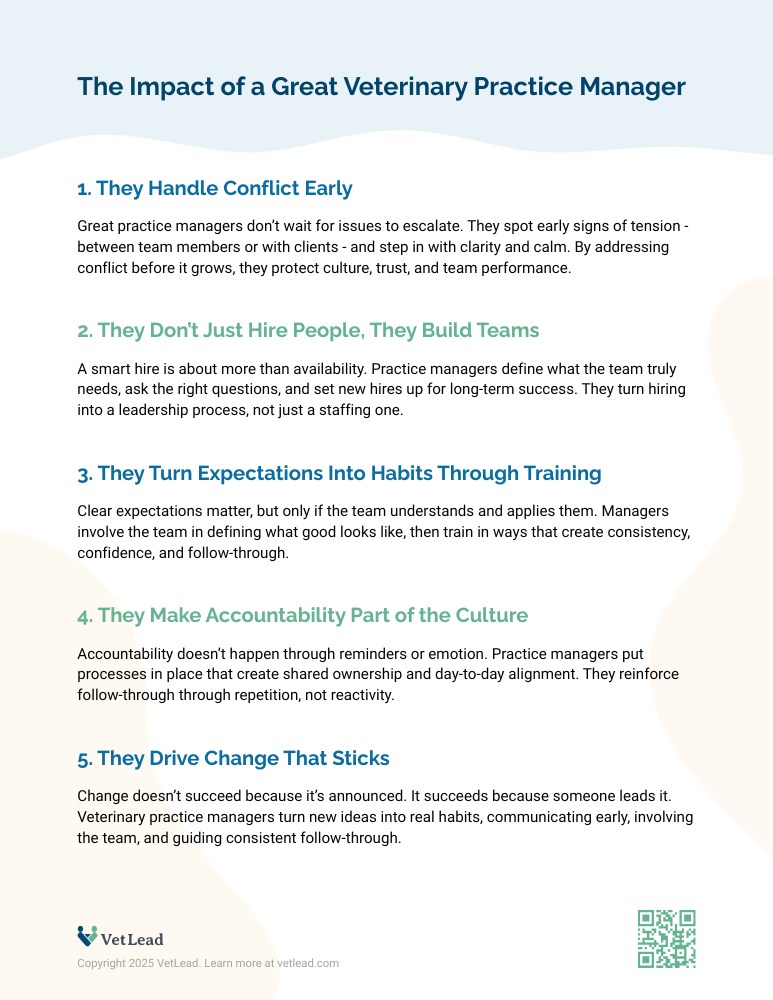Veterinary practice managers are easy to overlook.
They’re not diagnosing cases or performing surgery. They’re not the first face most clients see. They rarely show up in recognition posts.
But in most veterinary practices, they’re the difference between chaos and clarity.
Veterinary practice managers carry a unique and demanding responsibility. They lead teams, manage finances, handle conflict, implement change, and hold the entire operation together. And they often do it quietly, without the authority or support their role deserves.
If we want practices to run better, lead better, and grow stronger, we need to understand what veterinary practice managers really face, and what they actually do to move things forward.
The Reality of a Veterinary Practice Manager’s Role
Veterinary practice managers aren’t just multitaskers. They’re strategic operators trying to solve problems that often don’t have clear solutions.
They’re managing schedules, systems, personalities, and expectations, all while navigating financial constraints and operational stress. Most are doing this in the middle of staffing shortages and growing client demand.
They’re accountable for performance but often excluded from the decisions that shape it. And when the practice resists change, it’s the manager who has to translate, implement, and keep things from stalling.
What makes them remarkable isn’t that they stay calm under pressure. It’s that they consistently find a way forward, solve problems, adapt, and improve.
Let’s look at a few areas where veterinary practice managers create the most impact.
They Handle Conflict Early

Most conflict doesn’t start as a major issue. It starts as tension, misalignment, or a pattern that goes unaddressed until someone decides to step in.
They see tension between team members and address it early. They coach through passive behavior, clarify expectations, and deal with issues before they escalate into gossip or disengagement. They know that unspoken frustrations don’t just fade away.
They don’t let client complaints linger either. Veterinary practice managers know how to listen, respond, and bring clarity to difficult situations without making excuses or passing blame. They understand that client conflicts are often less about what happened and more about how it was handled.
When things feel tense or emotionally charged, internally or externally, they're often the person people turn to for resolution. Not because it's easy, but because they’ve learned how to do it well.
They Don’t Just Hire People, They Build Teams
Hiring isn’t just about filling shifts. It’s about shaping a team that works, grows, and stays.
Veterinary practice managers who hire well don’t rush. They define what good looks like, ask the right questions, and avoid bringing in the wrong person just to fill a gap. They understand the impact of a bad hire and they know how to avoid the wrecks.
But hiring doesn’t end with an offer letter. Great managers know how much the first day shapes an employee’s long-term engagement. A clear schedule, a personal welcome, and thoughtful onboarding all help new team members focus on relationships and learning in place of survival. When practices are intentional about how people start, they create teams that contribute faster and stay longer.
That’s where training begins. For great managers, it’s never just a checklist.
They Turn Expectations Into Daily Habits Through Training
Clarity is an important part of the foundation for everything a team does well. Without it, even skilled team members will struggle to meet expectations, or worse, create their own.
Veterinary practice managers don’t just explain tasks. They take time to define what good looks like in ways the team can understand and apply. And they don’t do it alone. They involve the team in that process so expectations are clear, shared, and realistic rather than just handed down.
Once those standards are in place, training becomes more than a checklist. It becomes a way to create consistency, build confidence, and help people succeed without guessing. Training in your veterinary practice should always reflect what the team needs to do, not just what someone says they should know.
They Make Accountability Part of the Culture
Veterinary practice managers understand that accountability is about ownership, not oversight.
They create a culture where expectations are shared, performance is visible, and everyone understands how to move forward when things don’t go as planned. Accountability becomes part of how the team operates, part of a day-to-day rhythm.
They put processes in place that make accountability part of how the team works every day rather than relying on reminders or emotion.They recognize when follow-through is missing and reset the standard. And they do it consistently, even when it’s uncomfortable.
They also know that accountability is for all staff, including future veterinary leaders. They don’t ask the team to embrace things they aren’t practicing themselves. That consistency is what helps accountability become a shared habit as opposed to a stated expectation.
They Drive Change That Sticks
Change doesn’t work unless someone makes it real. Veterinary practice managers are often that someone.
They don’t just pass along new protocols. They figure out how those changes affect scheduling, staffing, client flow, and team energy. They lead their team through the shift instead of pushing it from behind.
That often means navigating skepticism or resistance. But strong managers know that lasting change takes time, clarity, and buy-in. So they communicate early, involve the team, and build momentum slowly. They don’t confuse announcements with adoption.
Change isn’t a poster in the breakroom. It’s a process. And managers lead it one conversation, one process, and one team win at a time.

The Impact of a Great Veterinary Practice Manager
Download and share with leaders and teams. No email address required.
Veterinary Practice Managers Are Central to Success
Veterinary practice managers aren’t just handling logistics. They’re making hiring decisions, resolving conflict, coaching performance, and keeping the practice moving when things get hard.
They’re doing leadership work every day, often without the tools, time, or authority that real leadership calls for.
And that’s where practices have a real opportunity. Veterinary practice managers are already doing the work of leadership; what’s often missing is the support, clarity, and development that turns effort into sustained impact.
That doesn’t mean adding more to their plate. It means setting them up for success.
That looks like:
- Giving them access to training, not just tasks
- Including them in strategic conversations, not just tactical ones
- Listening to their insight before problems escalate
- Clarifying the authority they have to solve what they’re responsible for
Veterinary practice managers are already leading. When we recognize that and equip them accordingly everything else gets easier. The next step is VetLead membership, a resource that helps them lead more effectively and supports the entire practice.
What do you think? Other veterinary pros want to hear from you! Share your experience in the comments below.